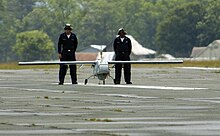AAI RQ-2 Pioneer
| RQ-2 Pioneer | |
|---|---|

| |
| RQ-2 Pioneer | |
| Role | Reconnaissance UAV |
| National origin | Israel/United States |
| Manufacturer | Israel Aircraft Industries
|
| Introduction | 1986 |
| Retired | 2007 |
| Number built | 175 delivered; 35 in service |
| Developed into | AAI RQ-7 Shadow |
The AAI RQ-2 Pioneer was an unmanned aerial vehicle (UAV) that was used by the United States Navy, Marine Corps, and Army, and deployed at sea and on land from 1986 until 2007. Initially tested aboard USS Iowa, the RQ-2 Pioneer was placed aboard Iowa-class battleships to provide gunnery spotting, its mission evolving into reconnaissance and surveillance, primarily for amphibious forces.
It was developed jointly by
Essentially, the Pioneer is an upgraded
Operation


Launched by
Internationally, Pioneer drones are perhaps most remembered for their role in the 1991 Gulf War, when a Pioneer launched by the Iowa-class battleship USS Wisconsin (BB-64) observed Iraqi troops on Failaka Island surrendering shortly after USS Missouri's attack on their trenchlines. When navy officials offered to transfer a Pioneer to the Smithsonian Institution, curators at the National Air and Space Museum specifically asked for the UAV that Iraqi troops surrendered to during the Gulf War.[2]
In the 1991 Gulf War, the US Army operated a UAV Platoon from Ft. Huachuca, Arizona. The UAV Platoon conducted flight surveillance and target acquisition missions from KKMC and later, the unit pushed north (Operation Sand Hawk) where US Army combat engineers built a metal runway for the aircraft to launch and recover.[3]
The "R" is the Department of Defense designation for reconnaissance; "Q" means unmanned aircraft system. The "2" refers to its being the second of a series of purpose-built unmanned reconnaissance aircraft systems.
Specifications (RQ-2)
- Primary Function: Psychological Operations

Data from [citation needed]
General characteristics
- Length: 4.3 m (14 ft)
- Wingspan: 5.151 m (16 ft 10.8 in)
- Height: 1.006 m (3 ft 3.6 in)
- Airfoil: NACA 4415[4]
- Gross weight: 205 kg (452 lb)
- Fuel capacity: 44 to 47 L (11.6 to 12.4 US gal; 9.7 to 10.3 imp gal)
- Powerplant: 1 × piston engine, 19 kW (26 hp) or UEL AR-741rotary engine; 28.3 kW (38.0 hp)
Performance
- Range: 185 km (115 mi, 100 nmi)
- Service ceiling: 4,600 m (15,100 ft)
Avionics
Dual Sensor (12DS/POP-200/POP-300)
Operators
Former operators
- United States Army
- UAV platoon deployed in Fort Huachuca, January-May 1991.[5]
- United States Navy
- VC-6 "Firebees": Naval Station Norfolk (decommissioned)[6]
- Training Air Wing 6 UAV Detachment: Naval Air Station Whiting Field (decommissioned)[7]
See also
Related development
Aircraft of comparable role, configuration, and era
Related lists
References
- ISBN 978-1-56347-644-0.
- ^ "Pioneer RQ-2A UAV". Collections.nasm.si.edu. Archived from the original on 2 April 2011. Retrieved 2011-03-18.
- ^ "Pioneer Short Range (SR) UAV". fas.org. Retrieved 2021-01-30.
- ^ Lednicer, David. "The Incomplete Guide to Airfoil Usage". m-selig.ae.illinois.edu. Retrieved 16 April 2019.
- ^ "Pioneer Short Range (SR) UAV".
- ^ Thompson, Coleman (2008-08-08). "Fleet Composite Squadron 6 Deactivates". NavNews. United States Navy.
- ^ Stegherr, Laura K. (2007-11-08). "UAV DET Launches Final Pioneer Flight". NavNews. United States Navy.
